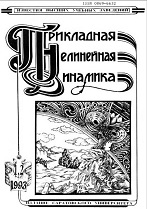|
This article is cited in 5 scientific papers (total in 5 papers)
APPLIED PROBLEMS OF NONLINEAR OSCILLATION AND WAVE THEORY
SIRS-model with dynamic regulation of the population: Probabilistic cellular automata approach
A. V. Shabunin
Saratov State University
Abstract:
Aim. Construction a model of infection spread in the form of a lattice of stochastic cellular automata which can demonstrate nontrivial oscillating regimes; investigation of its dynamics and comparison with the mean-field model. Method. Numerical simulation of the square lattice of cellular automata by the Monte Carlo approach, theoretical and numerical study of the structure of the phase space of its mean-field model. Results. A modified SIRS-model of epidemic propagation has been proposed in the form of a lattice of stochastic cellular automata. It uses dynamic regulation of the population with limit on the maximum number of individuals and takes into account the influence of the disease on reproduction processes. The study has discovered that, depending on the control parameters, the model demonstrates four different steady-state regimes: (a) total dying of the population, (b) stationary course of the disease, (c) complete recovery of the deases and (d) self-sustaining fluctuations of the infected, which accompanied by fluctuations of the population. The last regime is manifested near the border of the zone of complete recovery and is characterized by irregular bursts in the number of ill with a clearly distinguishable periodic component. At periodic modulation of the parameters the model demonstrates noisy periodic or quasi-periodic oscillations. Discussion. In general, the cellular automata model behaves similarly to the mean field equations, however there are quantitative and qualitative differences.The first ones consist in small shifts in the average concentrations compared to theoretically predicted values. These shifts are significantly reduced when individuals in the population can migrate. This effect can be explained by the greater homogeneity of populations in this case. The qualitative difference is that, the model of cellular automata demonstrates the effects, which are absent in the mean-field equations: a threshold of ill individuals necessary for the epidemic spread, and the oscillatory regime. A suggested cause of the last effect is the probabilistic nature of cellular automata, which lead to random fluctuations of the concentrations. The last ones can be amplified just as it happens in excitable systems under external noise.
Keywords:
SIRS-model, lattice of cellular automata, population dynamics.
Received: 14.12.2018
Citation:
A. V. Shabunin, “SIRS-model with dynamic regulation of the population: Probabilistic cellular automata approach”, Izvestiya VUZ. Applied Nonlinear Dynamics, 27:2 (2019), 5–20
Linking options:
https://www.mathnet.ru/eng/ivp101 https://www.mathnet.ru/eng/ivp/v27/i2/p5
|

|




 Contact us:
Contact us: Terms of Use
Terms of Use
 Registration to the website
Registration to the website Logotypes
Logotypes








 Citation in format
Citation in format 
